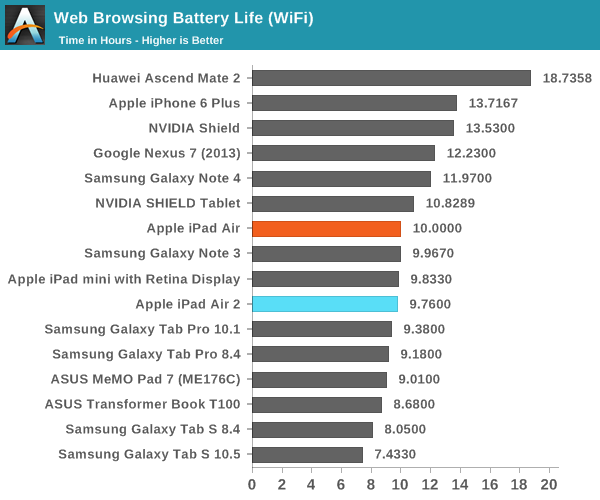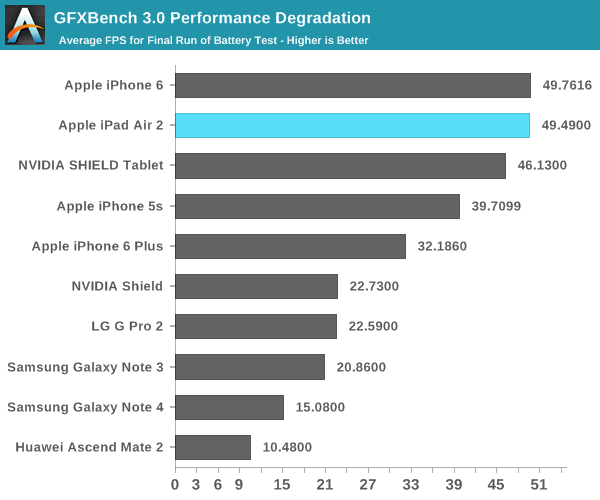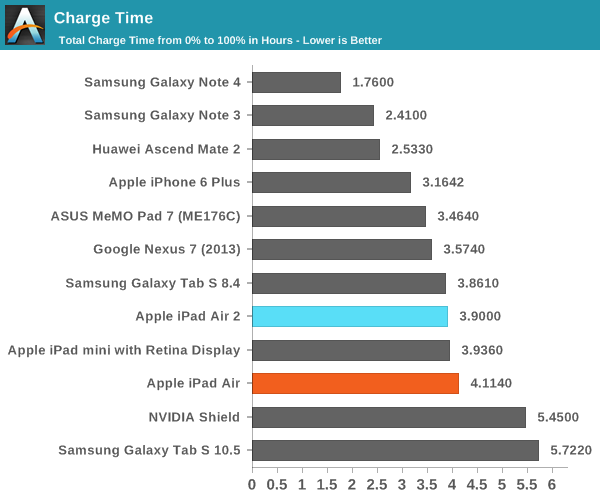The Apple iPad Air 2 Review
by Joshua Ho on November 7, 2014 9:30 AM EST- Posted in
- Tablets
- Apple
- Mobile
- iOS
- ipad Air 2
Battery Life
With the move from featurephones to smartphones, battery life has been and continues to be a critical issue. While it wasn’t unusual to see a week or more of battery life on a featurephone, some of the earliest smartphones couldn’t even last a day. While tablets seem to have a much easier time achieving high levels of battery life by virtue of massively increased volume, they still face similar issues as they are often used for gaming or other more intensive workloads that a smartphone is unlikely to see nearly as often. In order to test this, we run our tablets through a standard suite of tests of various use cases. In all cases where the display is on, all displays are calibrated to a brightness of 200 nits to draw useful relative comparisons.

In our first test, we see that the iPad Air 2 is about roughly equivalent to the original iPad Air for WiFi web browsing. This is actually a bit surprising as the battery in the iPad Air 2 is approximately 84% of the iPad Air. This would mean that we would expect the iPad Air 2 to get around 8.4 hours of battery life in this test, which represents a 16% gain to efficiency. It’s likely that these improvements to battery life come from the new process node on the A8X, along with the newer WiFi module.

Along the same lines, the LTE web browsing test tracks quite closely but it seems that there’s a minor decrease in efficiency gains when compared to WiFi. This difference is likely to be explained by the much higher bandwidth available in WiFi when compared to LTE.
While the web browsing tests are effective at ensuring faster SoCs aren’t punished, this inherently tilts battery life towards a more display-bound mode rather than compute-bound. Unfortunately short of a jailbreak it doesn’t seem possible to get an effective Basemark OS II battery test, so we’re mostly limited to a test of GFXBench’s unlimited rundown.


As one can see, the iPad Air 2 is one of the best performers on this test, considering its frame rate and runtime. While NVIDIA's GK20A GPU in Tegra K1 can get close to the GX6650 for short periods of time, over a long workload it's pretty clear that the GX6650 on 20nm has better sustained performance and significantly superior efficiency as it doesn't throttle until the 200th iteration of the test. It's important to note that the iPad Air 2 is running at a higher native resolution here, so relative to SHIELD Tablet a scaling factor needs to be estimated in order to get an idea for performance at the same resolution. During this test I saw that the skin temperatures never exceeded 45C, so this isn't the result of Apple choosing to run the device hotter than most.
Charge Time
While tablets deliver some great battery life in general, charge time tends to be much slower than that of smartphones as the battery is much larger and charging the device isn't as time critical due to the longer battery life . While we can't quite cover the full range of battery life uses cases, it's important to remember that in cases where the platform is otherwise identical beyond display that battery life scales linearly with overall capacity. In order to test charge time, we measure the time it takes for the battery to reach 100% from a fully-depleted state.

As one can see, the smaller battery seems to have a noticeable impact on charge time, although the difference isn't really all that notable as the difference is only around ten minutes at the end of the day.











226 Comments
View All Comments
hughlle - Friday, November 7, 2014 - link
iOS may not be perfect..Damned right. The nexus 9 could offer half the performance of this and i'd still pick that due to no other reason than iOS.
Desusenam - Friday, November 7, 2014 - link
Indeed, exactly the reason I just bought a Nexus 9. That and not needing to install iTunes.However, I'm still annoyed I can't yet buy the cover for the Nexus 9. When I bought the iPad 2, it came with the cover I bought at the same time. I can see why some people like the Apple experience...
dmunsie - Friday, November 7, 2014 - link
You do know that you don't need iTunes to setup and use an iOS device anymore, right? Been that way since iOS 5 (2011).Desusenam - Friday, November 7, 2014 - link
Cheers, I had no idea, I must be someone companies really like, they get a bad experience, go somewhere else and never look back...darwinosx - Friday, November 7, 2014 - link
Most Android users have no idea.ITunes hasn't been required in years.
Tikcus9666 - Friday, November 7, 2014 - link
until you install an update that bricks the device, then you need a pc or mac with itunes to fix it....iOS 8.0.1 update anyone
svan1971 - Friday, November 7, 2014 - link
um other than just itunes and a pc to fix a bricked apple device, how about listing the items required to fix an android device thats been bricked?StevoLincolnite - Friday, November 7, 2014 - link
On WIndows Phone, I just press two buttons and it un-bricks itself.sprockkets - Saturday, November 8, 2014 - link
"On WIndows Phone, I just press two buttons and it un-bricks itself."Then your phone wasn't bricked.
Nokia has tools just like everyone else that runs on a pc to fix a phone. Except Google's can be fixed with macs and Linux.
akdj - Thursday, November 27, 2014 - link
And with iOS, you can fix on a Mac, Windows PC OR Linux!& you're coreect. A pair of buttons doesn't (un)brick a phone of any make, model, manufacturer or OS